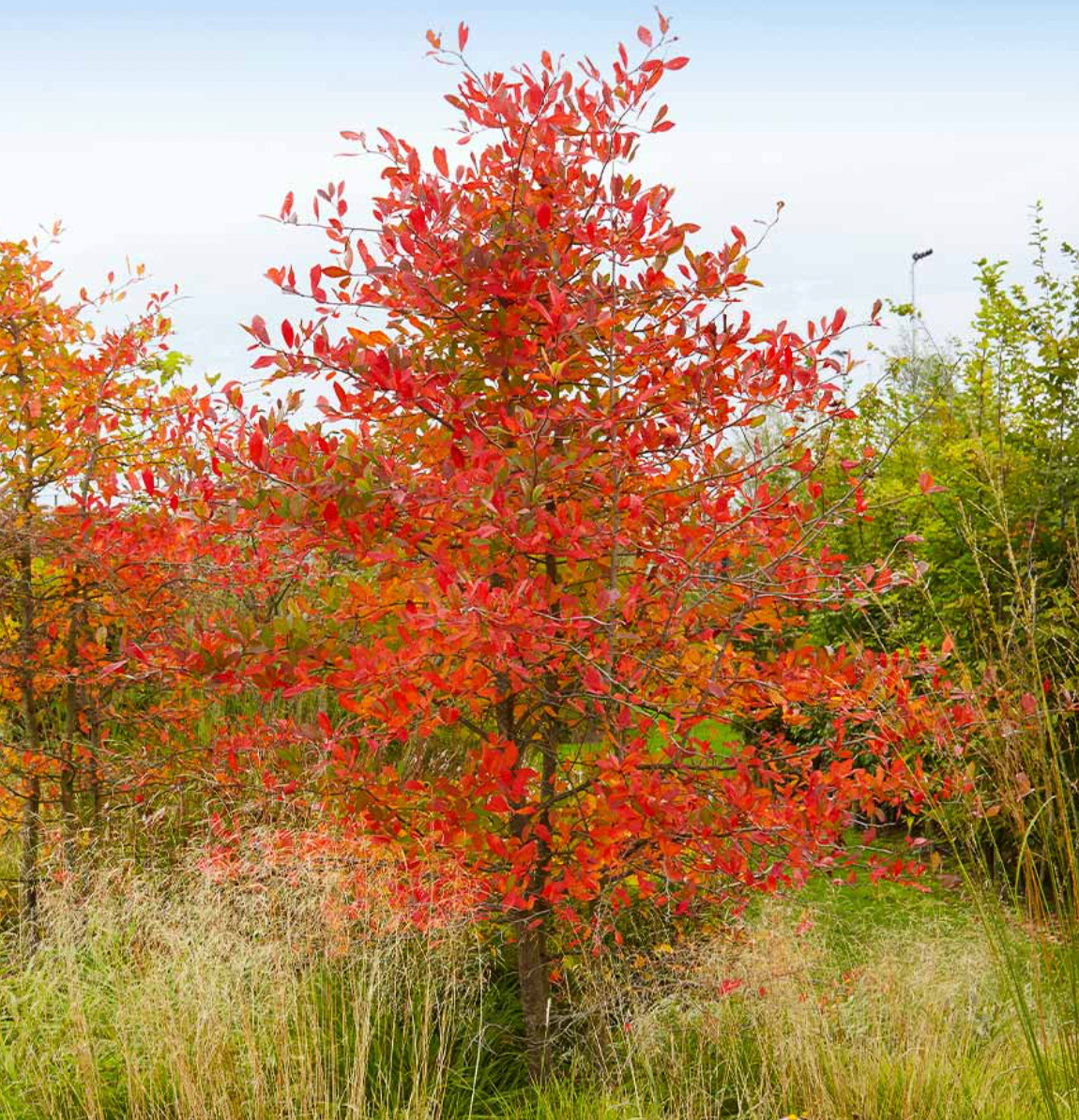Serviceberry Tree Autumn Brilliance: Complete Care Guide

The autumn brilliance serviceberry tree is a small tree or an upright shrub with spreading branches. In ideal conditions, the tree can reach a height of 20 to 25 feet. It grows five-petaled flowers in early May or late April, depending on your climate. Proper serviceberry tree autumn brilliance care can help you start your own backyard orchard in just a few years.
Fast Facts for the Autumn Brilliance Serviceberry Tree
| Common Name | Autumn Brilliance, serviceberry |
|---|---|
| Scientific Name | Amelanchier grandiflora |
| Month(s) of Harvest | Late April to early May |
| Light | Needs at least four hours of sunlight every day for the best fruit and color |
| Water | Has moderate watering needs and can withstand dry spells but is not as drought-tolerant as the Saskatoon serviceberry |
| Soil | Grows well in sandy, well-drained soil with a pH of 5.5 to 7. It can also tolerate alkaline pH soils of around 8. |
| Fertilizer | Requires a 5-3-3 fertilizer from early April to October end at intervals of six weeks for berry production; the fertilizer must be scattered around the plant's drip lines, which is the region where the rain drops when it falls off the serviceberry's outermost leaves |
| Pests | Can be affected by aphids |
| Diseases | Prone to canker, fire blight, leaf spot, and rust |
| Growing Zone | 3 to 9 |
Table of Contents
How To Take Care of Autumn Brilliance Serviceberry Trees

Being a small tree, the autumn brilliance serviceberry can thrive in your yard or garden. Here's what you need to know about autumn brilliance tree care.
Soil & Container
Serviceberries can tolerate multiple soil types, but you should avoid planting them in poorly-drained, wet, and heavy soils. Hard clay soils are also unsuitable for autumn brilliance serviceberry since they restrict root development.
The best soil for autumn brilliance serviceberry has a pH between 5.5 to 7, is well-drained, and is moist.
As for the container, make sure it's deep and wide enough to allow for root growth. You should also use a potting soil mix that's well-aerated.
Root Inspection
Even when growing them in pots, you have to transplant autumn brilliance serviceberries after they outgrow their containers. After you take the potted plant out, wash the roots with a strong stream of water.
Look for the following:
- Broken roots
- Dead roots
- Circling roots
Cut off the dead or broken roots and position the circling roots in a way that they face outward from the serviceberry trunk.
Water Requirements
The aim of watering autumn brilliance serviceberry is to keep its soil moist but not excessively wet. Most expert growers recommend drip irrigation since it lowers the risk of fungal leaf spot and other diseases.
Drip irrigation is a cost-effective and efficient water delivery system that provides water to the root of the plant consistently. You'll need to invest in a drip irrigation apparatus, but once it's set up, there are little to no ongoing maintenance costs, except for minor repairs.
If you don't want to use a drip irrigation system, try manual irrigation instead. Water your plant twice a week for the first year of its growth. Also, put a layer of mulch at the tree's base to retain moisture.
After the first year, water your plant every two weeks. You can also only water your autumn brilliance serviceberry during dry spells. However, it will only produce berries when it's well-hydrated.
When watering, do not soak the serviceberry's leaves since moisture invites fungal growth.
Fertilizing and Filling
Apply a 5-3-3 fertilizer to the drip line of the autumn brilliance serviceberry tree from April to October. A 5-3-3 fertilizer has 5% nitrogen, 3% phosphorus, and 3% potassium.
When spring arrives, and the buds break, apply a 16-16-16 fertilizer to the plant. About four ounces of this fertilizer should be enough for the plant to produce beautiful blooms.
Sun & Placement
The autumn brilliance serviceberry tree thrives in USDA zones 3 to 9. It requires partial shade with full sun. Four hours of direct sunlight every day will ensure the production of delicious fruit and white flowers on the tree.
Since state governments approve the autumn brilliance serviceberry for planting under power lines, you can use it for landscaping.
Plant it in an area that's free of tall trees, buildings, and other obstructions since these can shade the tree from the sun.
Temperature and Humidity
The temperature in Zone 4 can drop from -30 °F to -20 °F, while in Zone 9, it remains between 20 °F to 30 °F. Since the autumn brilliance serviceberry tree thrives in these temperatures, you don't need to worry about adjusting the climate.
Humidity levels should remain between 50 and 80 percent for the tree to grow and bear fruit. If you live in an area with high humidity, consider using a dehumidifier to maintain optimal levels, as high air moisture can result in diseases.
Pruning
Prune your autumn brilliance serviceberry trees in late winter or early spring. Only prune damaged, diseased, or weak branches in the first three years of the tree's growth. After that, you can prune more vigorously for height and shape control. Sterilize your pruning tools before and after use to prevent the spread of diseases.
Did You Know? George Washington planted the autumn brilliance serviceberry tree on his Mount Vernon estate.
Common Serviceberry Tree Problems
All serviceberry varieties are susceptible to several diseases, such as rust, leaf spot, and pest attacks. Look for the following concerns in your trees.
Discolored and Wilted Leaves
If your autumn brilliance serviceberry has discolored leaves that have been wilting for some time, it may be affected by one of the following conditions.
Juniper Broom Rust
Caused by Gymnosporangium nidus-avis, the condition results in small yellow leaf spots on serviceberry leaves. These spots have a red border and often grow into brown blotches.
Besides the leaves, the spots are also present on green twigs and petioles. Prolonged infection can turn leaves and young shoots completely brown.
The infected twigs and lower sides of the leaves also have tube-shaped fungal bodies that produce spores to infect nearby plants.
Black Witches' Broom
Apiosporina collinsii causes black witches’ broom, a condition in which olive-colored spots form on the leaves undersides. These are the fungal spore-producing fruiting bodies. The leaves initially turn yellow and then black before falling off.
Blister Canker
Canker is common on drought-stressed and wounded serviceberry trees. It is caused by Biscogniauxia marginata and manifests itself as yellow-orange lesions on infested twigs. The cankers are girdled, and the bark begins to crack, causing leaves to wilt.
Discolored Flowers
Fire blight is the main reason behind your autumn brilliance serviceberry flowers losing their color. The condition is caused by Erwinia amylovora, which infects the leaves, blossoms, and young shoots.
Flowers turn gray initially and then blacken over time. Meanwhile, leaves also turn gray or dark brown before dying. Infected fruits and leaves often stay attached to the tree.
Holes in Branches
The Roundheaded appletree borer forms holes in the branches of serviceberry trees. Its larvae are round, cream-colored, and legless. Meanwhile, adult insects are brown and nearly 3/4 inches long.
Another pest, called the Shothole borer, may also chew through the serviceberry bark, making holes about 1/4 inch in diameter. They mainly attack weak or stressed trees. Prune the branches infested with borers to get rid of them.
Learning About Serviceberry Trees
The serviceberry tree autumn brilliance is a versatile tree that you can grow for ornamental, landscaping, or shade provision. Some nicknames of the autumn brilliance serviceberry include Juneberry and Shadbush.
Since the autumn brilliance serviceberry tree is a natural hybrid of other serviceberry varieties, it is more resilient and can tolerate harsher climates.
Its white flowers arrive in spring, which will add to your yard's aesthetic value. In a while, the beautiful spring flowers pave the way for green berries that gradually change color to red and rich purple in early summer.
These are edible fruits that you can bake in pies or eat raw. The edible berries of serviceberry trees are often called wild plum or sugarplum. Native Americans believed that these fruits had medicinal properties.
Even when the autumn brilliance serviceberry is not in bloom, you can appreciate its elliptical shape, blue-green foliage, and expansive shade.
When fall arrives, the tree's leaves change color to a brilliant orange-red. So, you can watch your autumn brilliance serviceberry change colors throughout the year.
Serviceberry Tree Origin Story
The autumn brilliance serviceberry is a hybrid cross of two North American serviceberry species; A. arborea (downy serviceberry) and A. laevis (Allegheny serviceberry).
The genus name of the autumn brilliance serviceberry derives from the French name for Amelanchier ovalis, which is a European plant of this genus. Meanwhile, its epithet translates to 'large flowers.' Today, many people know it for its showy flowers.
In English, we know it as autumn brilliance because of the beautiful orange-red color its leaves turn in the season.
Sweet New Earth's Final Word On Serviceberry Trees
Belonging to the same family as rose, the autumn brilliance serviceberry is an ideal addition to any garden due to its improved disease resistance and showy flowers.
On average, the tree grows up to 20 feet tall. Its leaves are arranged alternately and are ovate in shape. It has a silvery gray smooth bark that shows fissures with age.
Spring brings small pink flowers with five petals. After the flowers drop, the tree produces fruits that ripen in June. Although the autumn brilliance serviceberry grows best in Canada and the eastern United States, you can also grow it in other regions.
The fruit can be used in jams and jellies, while the foliage has ornamental value when planted near sidewalks, city parkways, parks, and patios.

Christina Hernandez
Christina has done most of her research on environmental science but recently has changed her focus towards sustainable forestry. She has a passion for the outdoors and wants to spread that passion to the world.
Join our community!
Join to receive guides, insights, and the latest gardening deals!
